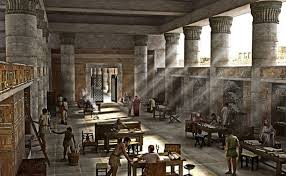
Library of Alexandria introduction and detailed
Ch. Bakht Yar Zafar and GPTchat
Abstract
The Library of Alexandria was one of the most renowned libraries of ancient times, located in the city of Alexandria, Egypt. It was founded by Ptolemy I Soter in the 3rd century BCE and was a major center of scholarship and research, housing a vast collection of texts on a wide range of subjects. The library was said to have held around 700,000 scrolls and was considered one of the largest and most significant libraries of the ancient world. The library was also a research institution, with a staff of scholars who used the collection for their research. Despite its grandeur, the library was destroyed multiple times over the centuries, most notably in 48 BCE by Julius Caesar during his civil war. Despite its destruction, the legacy of the Library of Alexandria continues to inspire and influence scholars and researchers to this day.
Overview
The Library of Alexandria was one of the most famous libraries of the ancient world, located in the city of Alexandria, Egypt. It was founded by Ptolemy I Soter, a general of Alexander the Great, around 295 BCE. The library was a major center of scholarship and research, and its collection included works on a wide range of subjects such as mathematics, astronomy, medicine, literature, and philosophy.
The library was said to have held around 700,000 scrolls, and it was one of the largest and most significant libraries of the ancient world. The library was also a research institution, with a staff of scholars who used the collection for their research. It was also a major center of translation, with many works being translated fr om other languages into Greek.
om other languages into Greek.
The library was destroyed multiple times over the centuries, due to various reasons such as fires and invasions. The most famous destruction was in 48 BCE by Julius Caesar during his civil war. The Library of Alexandria was partially rebuilt but it never fully recovered its former glory.
In addition to the main library, there were also several smaller libraries in Alexandria, such as the Daughter Library, which was located in the Bruchion quarter of the city, and focused on philosophy and the sciences.
Despite the destruction of the library, the legacy of the Library of Alexandria lived on through the many texts and ideas that were preserved and passed on through the centuries. The library was a symbol of the power of knowledge and the pursuit of learning, and it continues to inspire and influence scholars and researchers to this day.
Is it first organized library of the world?
The Library of Alexandria is considered to be one of the first organized libraries in the world, but it is not considered to be the first.
Libraries have existed in various forms throughout history, with examples of archives and collections of texts dating back to ancient civilizations such as Mesopotamia and China. For example, in Mesopotamia, the library of Ashurbanipal in Nineveh (7th century BCE) is considered to be one of the first true libraries, and it held a collection of over 30,000 clay tablets.
Similarly, in China, the Imperial Library of the Han dynasty (2nd century BCE) is considered to be one of the earliest libraries in China. It held a collection of texts and works on various subjects such as history, literature, and law.
The Library of Alexandria, while one of the most renowned, is not considered the first organized library in the world, but rather one of the most significant and advanced libraries of its time, known for its vast collection, research institution, and translation center.
It is not entirely clear what specific system was used to organize the materials in the Library of Alexandria. However, it is known that the library was a major center of scholarship and research, and it is believed that the library’s collection was organized
It is also known that the library had a system of cataloging the materials in its collection, which is similar to the modern library cataloging system. The library used indexing and cataloging to make the materials more easily accessible for patrons and scholars. The library’s catalog was said to have been divided into three sections: authors, subjects, and texts.
It’s worth noting that the knowledge about the Library of Alexandria is mainly based on the accounts of historians and scholars who lived centuries after the library was destroyed, so it’s possible that the information is not entirely accurate.
Material in Alexandria Library
The Library of Alexandria had a vast collection of texts and materials on a wide range of subjects, including but not limited to:
- Literature: The library had a large collection of works of literature such as epic poems, dramas, and historical texts, including many works that have since been lost to history.
- History: The library had a collection of texts documenting the history of Egypt and the wider Mediterranean region.
- Philosophy: The library had a collection of works on philosophy, including the works of famous philosophers such as Aristotle and Plato.
- Science: The library had a collection of texts on various scientific subjects such as mathematics, astronomy, medicine, and natural science.
- Religion: The library had a collection of religious texts from various cultures and religions, including texts from the ancient Egyptians, Greeks, and Romans.
- Maps and Geography: The library had a collection of maps and texts on geography, which were used by sailors and traders.
- Music: The library had a collection of texts on music theory and compositions.
- Art: The library had a collection of texts on art and architecture.
This is not an exhaustive list and the library’s collection covered many other subjects as well. The library’s collection was considered one of the most extensive and diverse in the ancient world, and it was a major center of scholarship and research.
Destory the library
The Library of Alexandria was destroyed multiple times over the centuries, so there is not one specific person or group that can be identified as having destroyed the library.
One of the most famous destructions was in 48 BCE by Julius Caesar during his civil war. According to historical accounts, Caesar’s army set fire to the ships in the harbor of Alexandria, and the fire spread to the city, destroying many buildings, including the library.
Another destruction was by the Roman Emperor Aurelian in the year 272 CE, when the city of Alexandria was captured by his troops, he set fire to the Brucheion district, where the library was located.

Additionally, it is believed that the library also suffered damage and losses over time due to natural disasters such as earthquakes, and looting by various conquerors and invaders.
It’s also worth noting that the knowledge about the Library of Alexandria is mainly based on the accounts of historians and scholars who lived centuries after the library was destroyed, so it’s possible that the information is not entirely accurate.
The purpose of destroying the Library of Alexandria is not entirely clear and is a matter of historical debate.
Some historians believe that the destruction of the library was a result of accidental fires, such as the one set by Julius Caesar during his civil war. Others argue that the library was deliberately targeted and destroyed as a symbol of the power and prestige of the city of Alexandria, and as a means of destroying the knowledge and culture that it represented.
Additionally, some historians argue that the destruction of the library was a result of political, religious or ideological reasons. For example, some argue that the destruction of the library was a way to erase the intellectual and cultural heritage of the previous ruling dynasty, or to silence dissenting voices or alternative ideologies.
It’s also worth noting that the knowledge about the Library of Alexandria is mainly based on the accounts of historians and scholars who lived centuries after the library was destroyed, so it’s possible that the information is not entirely accurate and other reasons not mentioned here might be behind the destruction of the library.
The total area of the Library of Alexandria is not well-documented in historical records. It is known that the library was located in the Bruchion district of Alexandria, which was a large area that included not just the library, but also other buildings and institutions such as the famous Mouseion (Musaeum) of Alexandria, which was a research institute and center of learning.  According to ancient accounts, the library was said to have had several different buildings or wings, each dedicated to different subjects or collections. However, it is not clear how large each of these buildings was or how much land they occupied.
According to ancient accounts, the library was said to have had several different buildings or wings, each dedicated to different subjects or collections. However, it is not clear how large each of these buildings was or how much land they occupied.
In addition to the main library, there were also several smaller libraries in Alexandria, such as the Daughter Library, which was located in the Bruchion quarter of the city, and focused on philosophy and the sciences.
Given the lack of precise data, it is difficult to estimate the total area of the Library of Alexandria with accuracy.
